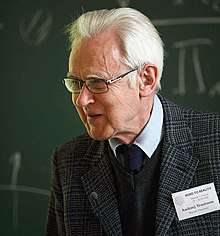Andrzej Trautman
Andrzej Mariusz Trautman (born January 4, 1933 in Warsaw) is a Polish mathematical physicist who has made contributions to classical gravitation in general and to general relativity in particular.
Andrzej Trautman | |
|---|---|
 Trautman in 2010 | |
| Born | 4 January 1933 |
| Nationality | Poland |
| Alma mater | Warsaw University of Technology |
| Known for | Robinson–Trautman gravitational waves Trautman recovery theorem in Newton–Cartan theory |
| Awards | Marian Smoluchowski Medal (1986) Prize of the Foundation for Polish Science (2017) |
| Scientific career | |
| Fields | Mathematics |
| Institutions | Institute of Theoretical Physics of Warsaw University |
| Doctoral advisor | Leopold Infeld |
He made contributions to gravitation as early as 1958.[1] The "Trautman-Bondi mass" is named after him.[2]
Biography
Trautman was born in Warsaw, Poland into an artistic family. His father, Mieczysław, was a painter and taught drawing at a secondary school in Warsaw. His mother, Eliza Trautman (née André), was French, though she was born in Spain, where her father, Marius André, was working as a French consular officer. His schooling, at the elementary level, was interrupted by the Warsaw Uprising of 1944. After spending about ten months in Germany, he returned, with his mother (his father had died in 1941) to Poland. In the fall of 1945, they both went to Paris, to stay with their family there. In France, Trautman attended a Polish secondary school from which he graduated in 1949 and returned to Poland shortly afterwards.
During the years 1949–55, he studied radio engineering at the Warsaw University of Technology. After earning a master's degree under the influence of Warsaw Tech's theoretical physics professor Jerzy Plebański,[3] he continued graduate work in Leopold Infeld's group at the Institute of Theoretical Physics of Warsaw University. This Institute was to become his permanent place of study and work. He obtained in 1959 the Ph.D. degree at the Institute of Physics of the Polish Academy of Sciences in Warsaw.[4]
Trautman and Ivor Robinson discovered a family of exact solutions of the Einstein field equation, the Robinson-Trautman gravitational waves.[5]
In 1981, Trautman became a founding member of the World Cultural Council.[6]
References
- Radiation and boundary conditions in the theory of gravitation, Bull. Acad. Pol. Sci., S´erie sci. math., astr. et phys. VI (1958), 407–412.
- Chrusciel et al "The Trautman-Bondi mass of hyperboloidal initial data sets" Adv. Theor. Math. Phys. 8 (2004) 83–139
- Trautman, Andrzej. "Short autobiography". Trautman's website. Retrieved August 5, 2005.
- Trautman, Andrzej. "Short autobiography". Trautman's website. Retrieved August 5, 2005.
- Ivor Robinson, Andrzej Trautman, "Spherical Gravitational Waves". Phys. Rev. Lett. 4 pp. 431–432 (1960).
- "About Us". World Cultural Council. Retrieved November 8, 2016.
External links
- Andrzej Trautman at the Mathematics Genealogy Project
- Christina Sormani, C. Denson Hill, Paweł Nurowski, Lydia Bieri, David Garfinkle, and Nicolás Yunes (August 2017). "A two-part feature: The Mathematics of Gravitational waves". Notices of the American Mathematical Society. American Mathematical Society. 64 (7): 684–707. doi:10.1090/noti1551. ISSN 1088-9477.CS1 maint: uses authors parameter (link)